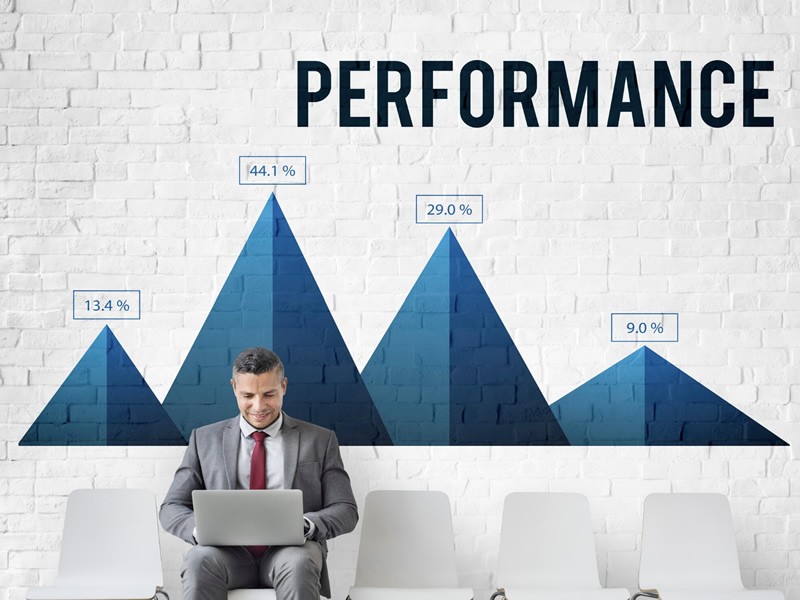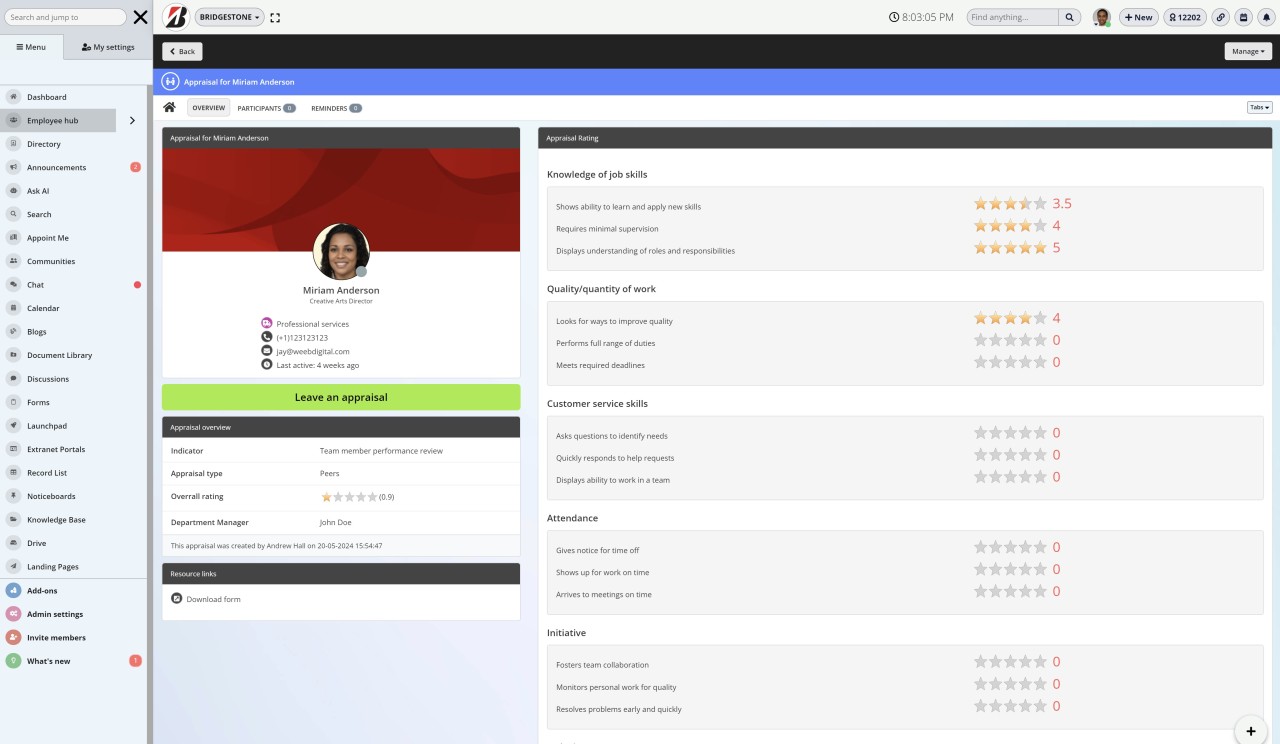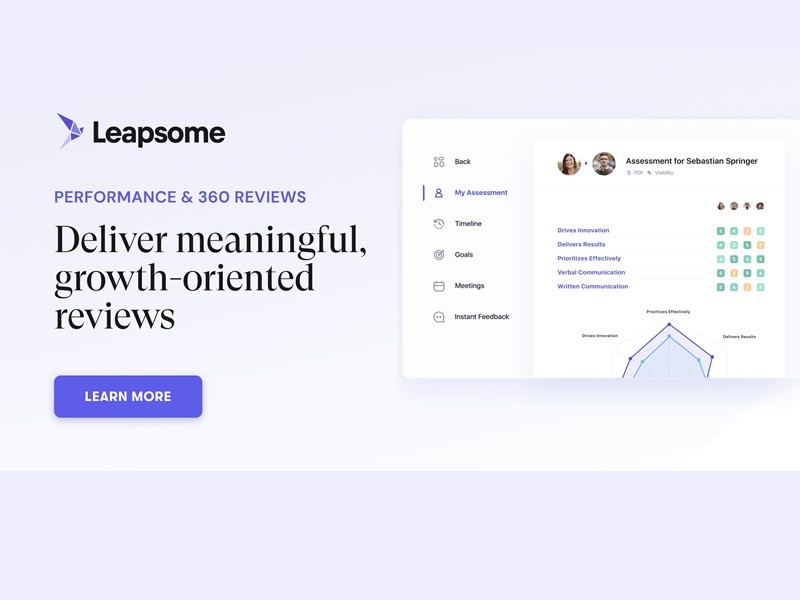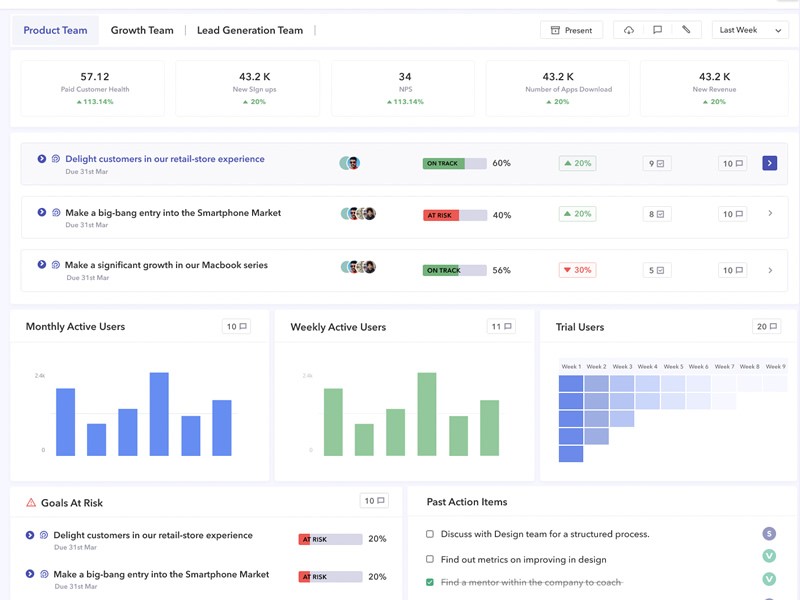Insight Blog
Agility’s perspectives on transforming the employee's experience throughout remote transformation using connected enterprise tools.
26 minutes reading time
(5267 words)
Featured
Employee Performance Reviews in 2024: The Ultimate Guide
A performance review is a formal regulated feedback mechanism in which managers and other key stakeholders assess an employee's work performance.
Performance reviews can be time-consuming, confronting, stressful, and costly.
You're not legally obliged to conduct performance reviews, so why do you need to do it?
A performance review system is an important tool for bringing out the best in your people and keeping your business running smoothly.
It allows managers to gauge whether employees are achieving expected performance levels and offer them important feedback, guidance, and encouragement.
It is also essential to identify and address poor performance before the problem leads to dismissal.
There are many ways to design and implement a review system, and it should be tailored to your company's size and structure.
Quality, responsive software can help schedule and track critical check-ins and meetings, taking care of all the admin-related tasks so you can focus on talking to your people.
Implementing a communication system for employee performance reviews centered around a personal development plan (PDP) with either an annual check-up or more frequent informal sessions offers compelling reasons for all businesses to conduct or maintain performance reviews.
What is a performance review?
A performance review is a formal, regulated process where managers and critical stakeholders evaluate an employee's work performance. The goal is to identify strengths and weaknesses, provide constructive feedback for future skill development, and assist with goal setting.
Regardless of the methodology used, a well-planned and executed performance review enhances employee engagement and fosters a culture of feedback and continuous development within your organization.
Performance reviews can uncover underlying issues, align individual goals with the company's objectives, and motivate employees by recognizing their achievements by creating an open dialogue between employees and management. This structured approach helps in personal and professional growth and contributes to higher overall productivity and job satisfaction. In addition, you can get help from an employee management software. It will help you assign distinctive roles to employees, actively tracks their progress, and helps you keep an eye on sales generated by them.
Your performance review process should include the following elements:
- Employee strengths: It's crucial to always provide feedback and praise for the team member's strengths, such as their effective problem-solving and communication skills. By highlighting these areas, you not only offer insight into what the employee is doing well but also foster a culture of appreciation and recognition, encouraging continued excellence.
- Employee weaknesses:Discuss any weaknesses or areas for improvement for the team member. Focus areas could include the ability to work in a team setting or the effectiveness of sharing ideas. This discussion provides the team member valuable insight into areas where they can improve.
- Rating system: To provide a comprehensive evaluation and identify areas for improvement, it's essential to include a rating scale to gauge each employee's skill level in predefined categories. A common example is rating employees based on standards such as: consistently exceeds expectations, often exceeds expectations, consistently meets expectations, and needs development. Use these ratings to evaluate the employee across different categories, like strategic mindset, communication skills, and team collaboration, giving you a clear picture of their performance.
- Review period:Measure an employee's performance relative to a set period during the performance review process. Each organization may do this differently, with common periods being annually, bi-annually, or quarterly.
- Set goals:Establish clear SMART goals to give employees a sense of where to improve and what to focus on in the future. SMART stands for specific, measurable, achievable, realistic, and time-bound, helping to clearly define performance expectations for your employees.
The importance of employee performance reviews
While outdated approaches persist, more organizations are unlocking the power of performance reviews. According to recent studies, companies with effective performance review systems experience 14.9% lower turnover rates and 24% higher profit margins. When employers conduct them correctly, employees tend to provide more helpful feedback to the company, gain motivation that can catapult their career development, and, crucially, help them achieve business goals.
Good performance reviews allow managers to deliver fair and actionable assessments to their direct reports. This can increase employee engagement by up to 60%, provide strong recognition and encouragement, and create tangible paths for employee growth rooted in accountability.
- Aligning Personal Roles with Business Goals - A performance review serves as an opportunity to ensure that everyone comprehends the organization's vision and objectives, as well as how their individual contributions contribute to the broader picture. Individual performance is integral to organizational success.
- Clarity in Job Roles - Performance management empowers individuals to evaluate their roles within the organization and address any uncertainties they may have. When both employees and supervisors have a clear understanding and ownership of their specific job responsibilities, workplace ambiguities are minimized. Each person is held accountable for their work and duties.
- Regular Performance Feedback - Consistent feedback fosters improved communication throughout the workplace. Performance reviews aid in identifying individual strengths and areas for improvement, offering employees a clearer grasp of the expectations placed upon them. Performance management serves as a motivational tool, encouraging employees not only to find greater satisfaction in their work but also to exceed expectations.
- Career Development - The performance review provides a platform to strategize and establish objectives for advancing an employee's career. Performance management also facilitates access to additional training or mentorship opportunities, laying the groundwork for HR to develop future succession plans.
- Recognition for Outstanding Performance - Performance management encompasses various forms of recognition to express appreciation for exemplary performance, such as time off and bonuses. The prospect of receiving an appraisal that exceeds expectations, acknowledging exceptional effort, serves as an incentive for employees to excel and may pave the way for future career advancements.
In organizations where performance management is done well, employees see reviews as one of many tools that help them succeed. According to a Gallup poll, 85% of employees who receive regular feedback believe it positively impacts their performance.
What are the challenges of performance review?
Performance reviews pose various challenges for both managers and employees. Firstly, there's the issue of subjectivity, where assessments can be influenced by personal biases or perceptions, potentially leading to unfair evaluations. Secondly, the frequency of reviews, often conducted annually or bi-annually, may need to offer timely feedback, hindering continuous improvement. This infrequency also makes it challenging to address issues promptly. Delivering constructive feedback is another obstacle. Managers must navigate delivering criticism effectively without demotivating employees, while employees must accept feedback gracefully.
Ensuring that performance goals align with organizational objectives can also take time, potentially resulting in misaligned priorities. Maintaining thorough documentation throughout the review can also take time and effort, leading to incomplete assessments or disputes. Time constraints further complicate matters, as conducting comprehensive evaluations requires significant time and effort, potentially causing managers to rush the process or need to pay attention to essential aspects. Engaging employees in the review process is crucial, yet some may view it as bureaucratic rather than an opportunity for growth, leading to disengagement.
Lastly, assessing intangible skills like communication and teamwork presents challenges, as these skills are essential but may require more work to quantify objectively. Overcoming these challenges requires clear communication, feedback training for managers, regular check-ins for alignment, effective documentation systems, and fostering a culture of continuous feedback and improvement.
Types of performance appraisal review
- Weekly or Fortnightly Performance EvaluationsWeekly or fortnightly performance reviews don't need to collect a vast amount of data each time or be particularly goal-oriented. They are helpful for record-keeping and ensuring that a project—mainly an agile or fast-moving one—stays on track week by week.
- Monthly Performance AppraisalsMonthly performance appraisals benefit businesses employing people on short-term contracts, freelancers, or new hires during their onboarding process as they transition from job descriptions to actual performance. New projects also benefit from monthly reviews to ensure they remain on track and meet organizational goals. Some employees prefer monthly check-ins over annual reviews.
- Quarterly Performance EvaluationsCompanies often divide their business year into quarters (Q1, Q2, Q3, Q4) with set goals, targets, and budgets. It makes sense to assess performance alongside these periods. Three months allows employees to achieve goals and targets and refine their organizational skills. Weekly, fortnightly, or monthly reviews can be aggregated each quarter to create a comprehensive report of an employee's progress for a review meeting.
- Annual Performance ReviewsWhile some businesses still conduct annual reviews, these are increasingly being supplemented or replaced by pulse surveys and 360 performance review throughout the year. What specific questions should be included in a 360 feedback questionnaire to gather comprehensive insights? Traditional yearly reviews often become overburdened with too much information, making them less manageable and less fair in evaluating an employee's efforts. They typically focus on past performance rather than future growth, and a year is too long for employees to go without feedback. However, reviews and feedback collected throughout the year and compiled into a 12-month performance report provide valuable information, mainly when feedback includes actionable items.
Follow us and access great exclusive content everyday: Follow us on Google News
8 Benefits of Performance Management
Apart from the mentioned increase in profitability, what additional advantages can Performance Management offer?
1.Boosts morale
Everyone appreciates acknowledgment for their hard work. Performance reviews offer an ideal platform to formalize and document commendations. However, reviews shouldn't solely focus on setting objectives for the upcoming quarter; they should also create an opportunity for line managers to acknowledge individuals within their team.
Content employees are more productive. An astonishing 69% of employees stated they would increase their efforts if they felt their contributions were acknowledged. More than merely receiving a paycheck is required; regular feedback and reviews are crucial for sustaining employee morale.
You may also like: Best Apps for Employees: UPDATED 2022 – A Complete Guide
2.Flags training needs
Increasing the frequency of reviews, whether formal or informal, can enhance our understanding of employees' skill sets. Offering an open forum for employees to regularly share and discuss their roles can assist in identifying training needs before they adversely affect productivity.
Whether employees require improvement in specific skills or need to stay updated on emerging trends in their roles, Performance Management and regular reviews can pinpoint any deficiencies or future training needs.
To implement more frequent reviews effectively, start by establishing a clear schedule for both formal and informal evaluations. This could involve setting up monthly or bi-weekly check-ins with each employee. During these meetings, create a comfortable environment where employees feel encouraged to openly discuss their roles, challenges, and areas where they feel they could benefit from additional training.
Encourage managers to actively listen to employees' feedback and concerns, and to provide constructive guidance and support. Additionally, utilize tools and resources such as performance management software or templates to streamline the review process and ensure consistency across evaluations.
Regularly assess employee performance against predetermined goals and objectives, and use these assessments to identify any skill gaps or training needs. Once areas for improvement are identified, work with employees to develop personalized development plans that outline specific training opportunities and resources to help them enhance their skills and stay up-to-date with industry trends.
Lastly, foster a culture of continuous learning and growth within the organization by promoting ongoing feedback and encouraging employees to take ownership of their professional development. By implementing these steps, you can effectively leverage more frequent reviews to better understand employee skill sets and proactively address any training needs.
3.Facilitates Identification of Promotable Employees
Regular reviews serve as valuable tools for assessing the performance of employees and determining their suitability for promotion.
Conducting consistent performance reviews for all employees enables managers to evaluate them objectively for promotion, salary increments, or transfers. This standardized approach not only ensures the selection of the most qualified candidate for promotion but also promotes transparency and fairness in the selection process.
4.Supports team planning
Regular reviews with employees, integrated into a comprehensive Performance Management strategy, can aid in workforce planning. Discussing current and anticipated workloads with employees can reveal any potential need for additional staff in the future.
Moreover, if employees are experiencing challenges with their current workloads, arrangements can be made to redistribute tasks among team members and prioritize essential responsibilities.
Utilizing scheduling software for employees can further streamline this process, ensuring that tasks are allocated efficiently and that team members' availability is optimized. This technology can also provide valuable insights into patterns of workload distribution, helping managers make informed decisions about staffing and resource allocation.
Placement: see attached
Here's how you can implement frequent reviews with employees as part of your Performance Management strategy to aid in workforce planning:
- Schedule Regular Check-Ins: Establish a cadence for regular one-on-one meetings or team check-ins to discuss workload and performance. Depending on your organization's needs, these meetings can occur weekly, bi-weekly, or monthly.
- Set Clear Objectives: Clearly define the purpose of these reviews, emphasizing the importance of discussing current and future workloads. Encourage open communication and feedback from employees regarding their workload challenges and concerns.
- Review Workload Allocation: Assess each employee's workload and capacity during these check-ins. Identify any bottlenecks or areas where additional support may be required.
- Identify Staffing Needs: Use the insights from these discussions to identify potential staffing needs or resource gaps within your team or department. Consider factors such as upcoming projects, seasonal fluctuations, or changes in business priorities.
- Prioritize Tasks: If employees struggle with their current workloads, work collaboratively to prioritize tasks based on urgency and importance. Explore opportunities to redistribute tasks among team members or adjust deadlines as needed.
- Support and Resources: Offer support and resources to help employees manage their workload more effectively. This could include additional training, tools, or assistance from other team members.
- Monitor Progress: Continuously monitor workload allocation and employee performance to ensure effective and sustainable adjustments. Regularly revisit workload discussions during performance reviews to address any ongoing challenges or changes in workload. You can also use employee management software to efficiently manage your employees, and staff members. It will help you assign distinctive roles to employees, actively tracks their progress, and helps you guide them when necessary.
By incorporating these steps into your Performance Management strategy, you can effectively use frequent reviews with employees to aid in workforce planning and optimize workload management within your organization.
5.Increases employee retention
According to research conducted by HR Daily Advisor earlier this year, companies that implement regular employee feedback experience turnover rates that are 14.9% lower than those where employees receive no feedback. High staff turnover can significantly impact a company's bottom line, as well as employee morale and productivity.
Performance Management ensures clarity in employee expectations and objectives, which are regularly reviewed. Introducing regular feedback sessions and reviews provides employees with opportunities to address and resolve any issues they may encounter.
Regular interaction between employees and managers fosters smoother communication and informs managers about their team's progress and potential challenges. This contributes to a more cohesive and productive work environment.
A well-designed performance review strategy includes formal and informal feedback mechanisms, prioritizes employee recognition, and promotes continuous learning and development.
Furthermore, when managers offer additional fringe benefits as part of performance reviews, it helps align employee goals with company objectives and enhances employee engagement. This, in turn, leads to improved performance and higher retention rates.
6.Provides greater employee autonomy
Once employees understand the business's broader objectives and their role in achieving them, they gain the autonomy to approach their responsibilities in their own way. Consequently, they experience higher levels of happiness, commitment, productivity, and loyalty than those whose actions are strictly dictated.
Regular feedback sessions and discussions between line managers and employees provide reassurance and enable the review of progress against agreed objectives. This cultivates a culture of trust and initiative among employees, where ideas and creativity are encouraged to flow freely. Such a culture ultimately benefits the business in the long run.
7.Improves accountability
Accountability is crucial for organizational success, yet achieving it effectively can be challenging. Too often, accountability is mistakenly associated with a culture of blame, which can severely harm company culture and employee morale. Proper accountability, however, is about defining a company's mission, values, and objectives, ensuring everyone understands their role in achieving them.
With AgilityPortal, implementing a Performance Management system in your business becomes effortless. You can tailor Performance Management forms, establish schedules, and send timely reminders to employees and managers to maintain momentum. Discover how we can bolster your Performance Management strategy in 2024 with a free demo today.
8.Helps define career paths
Establishing clear and tangible career trajectories within an organization gives employees a sense of direction and is a powerful motivator. When individuals clearly understand where their current role fits into their long-term career aspirations, they are more engaged and committed to their work. This clarity fosters a more profound sense of purpose and fulfillment, driving employees to invest their time and energy into advancing their skills and achieving their career objectives.
Moreover, well-defined career paths contribute to a substantial reduction in staff turnover. When employees see opportunities for growth and advancement within their current organization, they are likelier to stay loyal and committed. This leads to excellent team continuity, fostering a stable and productive work environment.
So, reduced turnover means lower recruitment and training costs for the organization, as valuable institutional knowledge and expertise are retained. Ultimately, investing in clear career pathways benefits individual employees and strengthens the organization's overall resilience and success.
Free ebook: How To Get Your Intranet Off The Ground
Preparing for Performance Reviews: A Step-by-Step Guide
To begin, familiarize yourself with the performance metrics and objectives relevant to each team member. This includes reviewing past performance evaluations, setting clear expectations for the upcoming review, and gathering necessary documentation or data to support your assessments. Additionally, consider scheduling pre-appraisal meetings with individual team members to discuss their goals, challenges, and accomplishments. This proactive approach demonstrates your commitment to their professional development and allows you to address any concerns or questions they may have before the formal review.
Take time to reflect on your own leadership style and communication approach. Consider how you can effectively convey feedback in a constructive and supportive manner while encouraging accountability and growth. You can foster a positive and productive atmosphere during the performance review process by honing your communication skills and adopting a collaborative mindset.
Thorough preparation is key to conducting successful performance reviews. By investing time and effort in advance, you can ensure that the review experience is productive and beneficial for you and your team members.
- Clear Your Schedule: Ensure that your calendar is free from any distractions or interruptions during your one-on-one meetings with team members. Minimize commitments earlier in the day to avoid delays or the need to reschedule the review. By prioritizing these meetings, you convey to your employees that their performance review is just as important to you as it is to them.
- Review Employee Experience Data: Take time before the meeting to review notes from the employee's most recent performance review. Reflect on the main themes discussed during the last meeting and any follow-up actions agreed upon. This preparation will help you contextualize the current review and identify areas for discussion and improvement.
- Be Open to Feedback: Allocate sufficient time during the review for the employee to share their feedback with you. Bring along a laptop or notebook to record their input, demonstrating your commitment to actively listening and addressing their concerns or suggestions. Remember, receiving feedback is as essential as providing it in fostering a collaborative and constructive dialogue.
- Anticipate Unexpected Topics: While the focus of the review should be on the employee's performance and development, be prepared for unexpected topics that may arise during the discussion. Employees may raise issues or share news that were not previously known to you. Maintain openness and receptiveness to whatever they bring up, even if it is not directly related to the review agenda. Take note of these topics for potential follow-up discussions or actions in the future.
Employee performance review template
Introducing an effective tool for enhancing workplace productivity and fostering professional growth: the Employee Performance Review Template. Designed to streamline the assessment process, this template provides a structured framework for evaluating employee performance across key areas such as job knowledge, productivity, communication, and teamwork. Here are some employee performance review template you can get started with.
How to give constructive feedback
Giving constructive feedback is essential for effective communication and fostering growth in both personal and professional settings.
Here are some critical strategies for providing constructive feedback:
- Be Specific: Provide detailed examples and observations to support your feedback. Vague or general comments can be difficult for the recipient to act upon.
- Focus on Behavior: Concentrate on the specific actions or behaviors you want to address rather than judge the individual's character or personality.
- Use the "I" Statement: Express your feedback using statements that begin with "I" to take ownership of your perspective and avoid sounding accusatory. For example, "I noticed that..." or "I feel that..."
- Offer Solutions: Instead of solely highlighting problems, suggest actionable solutions or alternatives help the individual improve. This demonstrates your support and commitment to their development.
- Be Timely: Deliver feedback promptly after observing the behavior or situation. Timely feedback allows the recipient to understand the context and make necessary adjustments more effectively.
- Balance Positive and Negative Feedback: While addressing areas for improvement is essential, remember to acknowledge and reinforce positive behaviors or achievements. This balance helps maintain motivation and morale.
- Encourage Dialogue: Invite the recipient to share their perspective and thoughts, creating an open and supportive environment for discussion. Active listening and empathy are key components of effective feedback exchanges.
- Follow-up: Check in periodically to see how the individual is progressing and offer ongoing support or guidance as needed. Continuous feedback helps reinforce desired behaviors and ensures accountability.
By incorporating these strategies into your feedback approach, you can provide valuable guidance and support that promotes learning, growth, and positive outcomes for individuals and teams. What is the Most Effective Way to Conduct Performance Evaluation? Step-by-Step Process
3 Employee performance review software
#1.AgilityPortal
AgilityPortal offers a versatile performance management system designed to keep your employees aligned with goals and facilitate continuous feedback. It provides evaluation templates, automated workflows, and customizable forms to expedite the implementation of your performance management program.
Why Choose AgilityPortal: AgilityPortal's robust data analytics enable managers to analyze performance trends and pinpoint areas for enhancement. Managers can assess an employee's progress across various domains such as skills development, project management, and overall task completion, comparing it with peers in the same role or department.
AgilityPortal also facilitates the establishment of SMART goals for individual employees and teams, with progress tracking capabilities over time. The goal section features a timeline, providing visual feedback on progress to individuals.
Standout Features and Integrations:
Streamlined Review Process: AgilityPortal simplifies the process of sending and receiving reviews. Managers can link specific goals to evaluations, add and share goal-related notes, and set up notifications to ensure timely completion. Team managers receive comprehensive reports on team performance and can customize their dashboard to monitor department and individual goals effortlessly.
Effortless Feedback Collection: AgilityPortal offers multiple survey options for managers to evaluate various aspects of team performance. Additionally, it supports multi-rater feedback, including 360-degree feedback from close colleagues, and features an employee self-assessment tool for individuals to evaluate their own performance prior to meetings with their manager.
Integration Capabilities: AgilityPortal seamlessly integrates with Google Workspace, Okta, and OneLogin, enhancing its versatility and compatibility with existing systems.
In summary, AgilityPortal provides a comprehensive performance management solution with advanced analytics, streamlined review processes, effortless feedback collection, and seamless integrations, empowering organizations to enhance employee performance and achieve strategic objectives efficiently.
#2.Leapsome
Leapsome is the go-to employee evaluation platform, favored by leading companies such as Spotify, Workato, and monday.com. It offers comprehensive features to streamline performance management and foster personalized learning, driving individual and organizational growth.
Why Opt for Leapsome: Besides its robust evaluation tools, Leapsome incorporates employee engagement surveys to identify critical drivers and track employee satisfaction over time. Customizable surveys and expert templates empower organizations to translate employee sentiment into actionable insights. Notably, its key highlights include customizable frequency, segmentation by department or performance, and automated analytics.
Standout Features and Integrations:
Leapsome's performance review cycles are not just adaptable and easily configured, they are a catalyst for engagement and productivity. With the option for automated recurrence at specified intervals, such as quarterly or annually, Leapsome helps organizations create a culture of continuous improvement. According to a Gallup survey, organizations with engaged employees experience 41% lower absenteeism and 17% higher productivity.
Key features include 360-degree feedback, expert question templates, skill frameworks, development paths, automation, and robust analytics. Additionally, Leapsome offers an OKR module to manage goals across company, team, and individual levels, supported by visual aids like goal trees for enhanced clarity.
For upskilling initiatives, Leapsome provides tools to create customized learning paths tailored to specific teams, skill sets, or topics. This supports continuous learning and development, which is critical for organizational adaptability in today's dynamic business landscape.
Integration capabilities extend to platforms like Active Directory, ADP, BambooHR, GSuite, HiBob, Jira, Microsoft Teams, PayFit, Personio, Rippling, and Slack, ensuring seamless compatibility with existing systems and workflows.
In summary, Leapsome empowers organizations to streamline performance management, drive employee engagement, and facilitate continuous learning, ultimately fueling individual and organizational success.
#3.Peoplebox
Peoplebox, a employee evaluation software, simplifies the process for HR leaders to recognize, reward, and retain top performers while aligning compensation decisions with business objectives.
Reasons for Choosing Peoplebox: It offers a unified platform for HR and business leaders to enhance team performance, retention, and execution. This encompasses various aspects such as performance reviews, aligned goals (OKRs), 1:1 meetings, surveys, compensation management, KPI tracking, initiative management, and strategic meetings.
Peoplebox emphasizes the significance of regular feedback and communication in nurturing employee growth. It provides features facilitating easy performance reviews, goal setting, and progress tracking. The software fosters ongoing feedback and communication between managers and employees, promoting regular check-ins and one-on-one meetings.
Standout Features and Integrations:
Centralized Data Management: Peoplebox provides a centralized platform for organizing and documenting evaluation data, simplifying performance assessment and feedback provision for managers.
Goal Setting and Tracking: It facilitates centralized goal-setting and tracking, enabling collaboration between employees and managers in goal management.
Automated Scheduling: Managers and employees can automate scheduling for one-on-one meetings, streamlining meeting setup and attendance.
Slack Integration: Peoplebox allows performance reviews to be conducted via Slack, eliminating the need for employees to use additional tools for feedback.
Analytics and Insights: The tool offers analytics and insights to help organizations comprehend employee performance trends and identify areas for improvement.
Comprehensive Integrations: Integrations include MS Teams, Salesforce, Jira, Asana, Google Analytics, HubSpot, Notion, Bamboo HR, Tableau, GitHub, and Slack. Its Slack/Teams integration extends beyond notifications, enabling performance reviews, engagement surveys, and OKR check-ins within the messaging platforms.
In summary, Peoplebox empowers HR leaders to optimize employee performance and engagement through seamless feedback processes, goal management, and comprehensive integrations, ultimately driving business success.
Features of Employee Evaluation Software
In my quest for the ideal employee evaluation software, the following features to gauge the capabilities of each platform:
- Tailored Evaluation Forms: This feature allows organizations to customize evaluation forms according to specific job roles, objectives, and competencies. It ensures that assessments remain relevant and aligned with the company's goals, thereby enhancing the effectiveness of the evaluation process.
- Goal Setting and Progress Tracking: Clear, measurable goals and tracking progress towards them are crucial for employee development and organizational success. This feature aids in aligning individual objectives with company goals, providing employees with a clear roadmap for achievement.
- 360-Degree Feedback: By gathering feedback from various sources, including peers, subordinates, and supervisors, this feature offers a comprehensive view of an employee's performance. Such a holistic approach fosters fair and balanced evaluations.
- Self-Assessment Capabilities: Allowing employees to assess their performance encourages self-reflection and personal accountability. It also provides valuable insights to managers regarding how employees perceive their strengths and weaknesses.
- Real-Time Feedback: This feature enables managers and peers to provide immediate feedback on an employee's work, facilitating continuous performance management. It aids in promptly addressing issues and recognizing achievements.
- Analytics and Reporting Tools: Robust analytics empower organizations to identify trends, strengths, and areas for improvement across teams or the entire organization. These insights inform data-driven decisions related to workforce management.
- Integration with HR Systems: Seamless integration with other HR systems, such as payroll and attendance tracking, ensures a smooth flow of information and reduces the need for manual data entry, enhancing efficiency and accuracy.
- User-Friendly Interface: An intuitive and easy-to-navigate interface ensures that employees and managers can utilize the software effectively without extensive training. This boosts adoption rates and ensures consistent usage.
- Mobile Accessibility: With remote work becoming increasingly prevalent, mobile access to evaluation software allows employees and managers to complete evaluations, check goals, and provide feedback from anywhere, at any time.
- Security and Data Privacy: Safeguarding sensitive employee performance data is paramount. The software must adhere to stringent security and privacy standards to ensure the secure storage and transmission of data.
Selecting employee evaluation software with the right mix of features will significantly elevate the effectiveness of your performance review process. By focusing on the features most essential to your requirements, you can confidently choose software that best aligns with your needs.
How to Choose a Performance Management Tool
Consider these points as you navigate through your employee evaluation software selection process:
Identify the problem you aim to solve. Understanding challenges will guide your selection criteria for performance management software. According to Gartner, 68% of HR leaders prioritize improving employee performance.
Assess who will use the software and determine the number of licenses required. Deloitte's research shows that organizations with highly engaged employees outperform their peers by 147% in earnings per share.
Clarify which existing tools will interface with the new software. Research by HR technologists indicates that 64% of organizations consider integration capabilities a critical factor when choosing HR software.
Review desired capabilities and establish metrics for success. A study by SHRM found that companies with a formal performance management process report higher levels of employee satisfaction (72%) compared to those without (62%).
Evaluate how the selected tool aligns with existing workflows and systems. McKinsey's report suggests that organizations investing in performance management solutions see a 22% increase in productivity.
Addressing these considerations with relevant statistics can streamline your tool selection process and maximize the effectiveness of your performance management efforts.
Wrapping up
A performance review serves as an excellent tool for assessing a team member's performance. It provides transparency regarding expectations and offers a platform for honest communication within the team.
Transparency in the process is key to encouraging candid feedback and fostering a desire for performance improvement. Effective communication lies at the heart of a successful review process.
Whether it's providing feedback with context or enhancing collaboration, AgilityPortal can assist in streamlining your communication efforts. Elevate your communication not only during performance reviews but also in day-to-day interactions with AgilityPortal's team communication software.
Categories
Blog
(2620)
Business Management
(320)
Employee Engagement
(210)
Digital Transformation
(175)
Growth
(119)
Intranets
(119)
Remote Work
(61)
Sales
(48)
Collaboration
(37)
Culture
(29)
Project management
(29)
Customer Experience
(26)
Knowledge Management
(21)
Leadership
(20)
Comparisons
(6)
News
(1)
Ready to learn more? 👍
One platform to optimize, manage and track all of your teams. Your new digital workplace is a click away. 🚀
Free for 14 days, no credit card required.

















